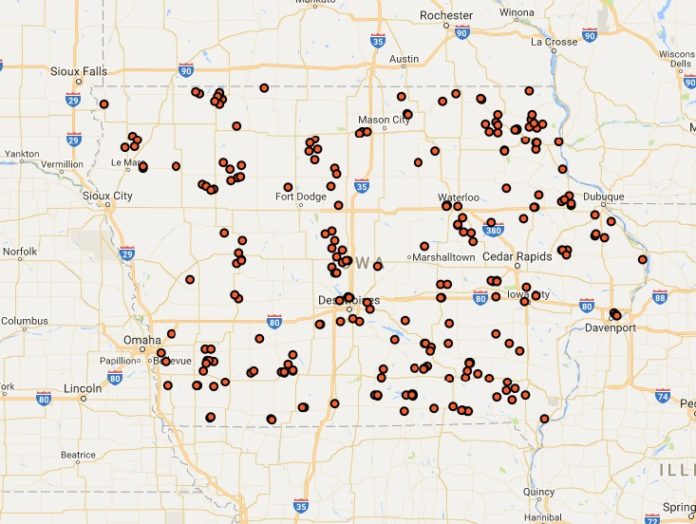
To the editor:
Over the past couple of years, we have heard a lot about water quality in Iowa. The issue has attracted more attention than I can ever remember it receiving during my 18-year career with the Iowa Department of Agriculture and Land Stewardship or during my time at the Iowa Department of Natural Resources.
And rightly so.
Water quality is and should be important to all Iowans. But just because we never used to talk about water quality, that doesn’t mean we’ve been ignoring it.
In 1971 the Iowa legislature passed a sediment control law that established soil-loss limits for every soil type in the state, making it the first of its kind in the nation, and in 1973 Iowa was the first state to appropriate state cost-share funds to work with landowners on addressing soil erosion. In 2013 Iowa was the second state in the Mississippi River Basin to develop a nutrient reduction strategy for the entire state.
Not once in these three examples were the words “water quality” mentioned, but all of these programs have had a major impact on the Iowa’s water quality.
So what’s the relationship between reducing soil erosion and protecting water quality?
Every ton of soil we keep in the field helps keep it out of the stream. Sediment is also a major transporter of phosphorus. If you stop the sediment, you stop much of the phosphorus too.
Keep in mind that reducing soil loss doesn’t solve all the water-quality concerns we have in the state, but it’s a great start, particularly in fields that have highly erodible soils.

We need to continue looking for more and better ways to address both phosphorus and nitrogen losses from our fields, but solving these issues requires multiple approaches. Some areas of the state are very susceptible to nitrogen losses while others lose more phosphorus.
Addressing water-quality issues across the state will require a diverse use of management practices, such as no-till and cover crops, structural practices, such as terraces and waterways, and edge of field practices, such as bioreactors and saturated buffers.
New and emerging technologies that have yet to be refined will also be a key if we are to continue making improvements.
So have we been ignoring water quality in Iowa? No. Water quality just wasn’t the buzz word at the time. Soil erosion was. The real question is: Can we do more? I believe the answer to that question will be coming soon.
The governor’s office, state legislature, ag groups and others have gone on record in support of additional funding for water quality. What that level of support ends up being has yet to be determined. As a lifelong Iowan, I’m looking forward to being part of the future efforts to protect our soils and continue to improve water quality in Iowa.
Vince Sitzman
Des Moines
Sitzman is the field services bureau chief in the Iowa Department of Agriculture and Land Stewardship’s Division of Soil Conservation and Water Quality.

















My son, Adam Michael Lack, was an operations supervisor at Poet’s Hanlontown, Iowa, ethanol plant in 2008, when he was murdered to cover-up the illegal drainage of about 50,000 acres of farm chemicals to an aquifer recharge area’s sinkholes in a Designated National Wetland in Cedar (W) Township, Mitchell County, Iowa. You can go to http://www.IowaColdCases.org to look up my son’s Cold Case file titled, “A Dead Zone Death,” and if you take the time to read his file and my notes there, called “Adam’s Voice,” you may get an understanding of why we were wanting the IDNR to release the contaminants that were testing at very high levels in our wells. IDNR is still hiding the contaminant well test data (for atrazine, arsenic, lead, anhydrous ammonia and CAFO nitrogen fertilizers) from well owners downstream even after the IDNR condemned my well.
I look forward to additional funding for water quality. Iowa sure needs it. I’d like to see some minor changes in allocating taxpayer dollars though. I’m a Soil and Water Conservation District commissioner for Dallas County. There is staff in the office and in offices throughout Iowa who know this state very well. They know where the problems are, and they know some of the best ways to attack the problems of soil loss and nutrient pollution. New funding should be targeted to projects that remove marginal land from production and attack the water-quality issue at the drainage-district and watershed level. These would become permanent solutions. It makes no sense to provide funding for projects that will be plowed under the next time commodity prices are high. The state will own more land. We will own more land. This land will be wetlands and wildlife areas that can be visited and hunted. And they will help solve our water quality and soil problems.
No matter how many sustainable farmers are following Iowa’s drainage laws and the EPA Clean Water Act’s anti-denigration laws here in Iowa, we will be drinking increasing levels of anhydrous ammonia, which is testing at higher levels in Iowa’s Source Waters. Paul Johnson, a former IDNR director, researched and published his data in July 1999 titled, “Groundwater Quality Response To Closure of Agricultural Drainage Wells.”
Since then, the USDA-NRCS encourages point-source pollution with French drains or the use of other illegal drainage outlets, such as draining wetlands down sinkholes, even as the IDNR charges a sustainable farmer with “blockage of water” in order to build a flood channel to further the draining of 50,000 acres of farm chemical run-off down sinkholes in an Aquifer Recharge Area and into the source water for 500,000 Iowans.
Big oil corporations make and sell anhydrous ammonia nitrogen fertilizer to some farmers, who break the drainage laws that our Republican governor and legislators refuse to enforce, and then continue to hide the well test data on nitrogen fertilizer contamination that kills animals and people in Iowa’s hygienic labs.
City dwellers don’t use anhydrous ammonia, but they are drinking it at increasing levels when farms use illegal drainage outlets, and when the Des Moines Water Works has to Chlorinate for the CAFO bacteria, the ammonia and the chlorine can cause lethal contaminants like trihalomethane.